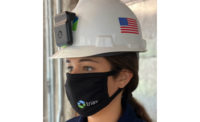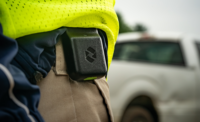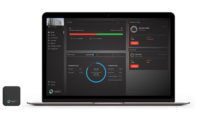When it was first introduced in 2016, Triax Technologies’ Spot-R clip was intended to detect when workers experienced a sudden fall, and pinpointing their location within a jobsite for safety responders. But the little clip has gotten a few new features over the years, and now include integration with access control checkpoints on jobsites.
“Right now we log when people come and go when they come into range of our network,” explains Pete Schermerhorn, CEO of Triax Technologies. The Spot-R technology locates workers via a custom wireless network set up on the jobsite, but it had not been compatible with other RFID-based systems used to track when workers come on and off of the jobsite.
“Now, on a controlled access site, we can show which turnstile workers go through, and combine that combines with geolocation information,” he explains. All of this will be visible on the Spot-R dashboard, and can be set up to work with existing access-control systems.
The new access-control feature does not require a higher subscription fee, and aside from some physical upgrades to turnstile systems the existing Triax network can be used to track workers on site. The Spot-R clip works on RFID and low-energy Bluetooth in addition to Triax’s proprietary network, so physical upgrades are minimal, says Schermerhorn. “We can use this to extend the core functionality of the Spot-R," he says. “We could track the opening and closing of the sites, track worker qualifications. It’s been a pretty loud voice from our customers that they don’t need to have workers wearing multiple RFID tags or clips for different uses.”
The Triax wireless network doesn’t record workers’ exact locations, only narrowing it down to predefined zones on the jobsite. The passive system does not have GPS, and does not track the wearer once they leave the range of the network on the jobsite. This greatly extends the months-long battery life, which is many cases can last the length of the project.
An Evolving Technology Finds Broader Use
The Triax Spot-R tags aren’t suited for every site, but the company has targeted it toward vertical construction and similar multistory jobs, where dense sites can be more easily covered by wireless repeaters. That has proven a good fit for Gilbane Construction, which has used the Spot-R tracking devices on over 20 jobsites in the last two years, including the renovation of a 35-story building in New York City.
“What really attracted us to this product was the fall-detection service it provided,” says Don Naber, Gibane senior vice president and director of risk management. “There were some initial growing pains, assigning and setting up the clips, but we found that we had an opportunity to change some [worker] behaviors.”
Gilbane’s early deployments of the Spot-R clips resulted in too many false-positive readings of fall incidents, as the contractor found the threshold to trigger the sensor was set too low. But after working with Triax and tweaking the settings for how many feet of sudden movement should trigger an alert, Naber says they began to see changes in the jobsite safety culture. “What we found was that while projects are in the initial stages of work, there’s not much building or foundation, and there are site excavations to avoid. So workers take shortcuts around the site, jumping down a few feet here and there,” he says.
“We saw subs taking routes to different parts of the site, jumping from one elevation to the next.” This lead to the contractor sitting down with the subcontractors and hashing out better, safer routes around the site. “They were saying to us, ‘we have a contractual obligation to you, Gilbane, to reach certain points of the site and we can’t,’” recalls Naber. “It changed how we look at the job and coordinate around the site. We made some adjustments to make it safer. Not to say we weren’t safe before, but the [Spot-R] improved our understanding of issues that weren’t being taken into account before.”
Naber says the clips have not only helped with avoiding catastrophic fall incidents, but in reducing repetitive stress on workers making short hops or drops while traversing a site. “And it’s not just from a repetitive injury standpoint, it’s from a twisted ankle or busted knee standpoint. It’s been a huge positive for us.”
“We’re changing behaviors,” adds Naber. “People a little bit more aware of their actions and surroundings with this clip on, and there is some level of prevention that you get just by creating an awareness.”





